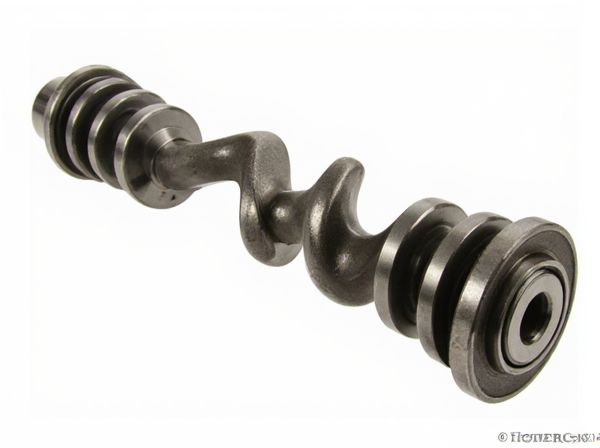
Photo illustration: Roller vs Slider Bearing Crankshaft
Roller bearings offer reduced friction and higher load capacity compared to slider bearings, making them ideal for high-performance crankshafts. Slider bearings rely on a thin film of lubricating oil to prevent metal-to-metal contact, which can be more suitable for heavy-duty applications but may generate more heat. Choosing the right bearing type ensures your crankshaft operates efficiently and increases engine longevity.
Table of Comparison
| Feature | Roller Bearing Crankshaft | Slider Bearing Crankshaft |
|---|---|---|
| Design | Uses rolling elements (rollers) for reduced friction | Uses sliding surfaces with lubricating oil film |
| Friction | Lower rolling friction, improves efficiency | Higher sliding friction, more energy loss |
| Load Capacity | Suitable for high radial loads | Handles heavier loads and shock better |
| Durability | Longer lifespan with proper maintenance | More wear prone but robust under shock |
| Maintenance | Requires less lubrication; simpler upkeep | Needs consistent lubrication and inspection |
| Cost | Higher manufacturing complexity and cost | Lower cost and easier production |
| Applications | High-performance and racing engines | Standard passenger and heavy-duty vehicles |
Introduction to Crankshaft Bearings
Crankshaft bearings play a critical role in engine performance by supporting the crankshaft and reducing friction during rotation. Roller bearings use cylindrical rollers to maintain separation between moving surfaces, offering low friction and high load capacity, especially beneficial for high-speed applications. Slider bearings, also known as plain bearings, rely on a thin film of lubricating oil to prevent metal-to-metal contact, providing durability and smooth operation under varying load conditions.
Overview of Roller Bearings
Roller bearings in crankshafts utilize cylindrical or tapered rollers to reduce friction and support radial and axial loads effectively. These bearings offer higher load capacity and durability compared to plain slider bearings, making them suitable for heavy-duty and high-performance engines. The design minimizes metal-to-metal contact, resulting in lower wear and improved engine efficiency.
Overview of Slider Bearings
Slider bearings, also known as plain or sleeve bearings, provide a smooth surface for crankshaft rotation by supporting the shaft on a thin film of lubricant that reduces friction and wear. These bearings are typically made from soft metals like babbitt or bronze, enabling them to conform to the crankshaft's shape and distribute loads evenly. Their design offers simplicity, effective shock absorption, and can accommodate misalignment, making them widely used in traditional internal combustion engines where durability and low maintenance are critical.
Key Differences Between Roller and Slider Bearings
Roller bearings use cylindrical rollers to reduce friction and handle higher radial loads, while slider bearings rely on a thin film of lubricant between sliding surfaces to support alignment and absorb impact. Roller bearings offer lower friction and greater durability in high-speed applications, whereas slider bearings provide smoother motion and better shock absorption under heavy loads. The choice depends on engine design requirements, with roller bearings favored for performance and slider bearings for cost-effective, reliable operation.
Performance Comparison: Roller vs Slider
Roller bearings offer lower friction and increased efficiency compared to slider bearings, enhancing engine performance by reducing power loss. Slider bearings provide better load distribution and durability under high pressure, making them suitable for heavy-duty applications. The choice between roller and slider bearings impacts crankshaft durability, energy efficiency, and overall engine reliability.
Durability and Maintenance Considerations
Roller bearings in crankshafts offer superior durability due to reduced friction and wear, extending the lifespan under high load conditions compared to slider bearings, which rely on a thin oil film and are more prone to wear over time. Maintenance for roller bearings is generally less frequent, as their design minimizes metal-to-metal contact, whereas slider bearings require regular oil changes and monitoring to prevent degradation and potential engine damage. Choosing roller bearings can decrease downtime and enhance engine reliability, especially in high-performance or heavy-duty applications.
Applications in Automotive Engineering
Roller bearings are commonly used in high-performance automotive engines due to their ability to reduce friction and improve durability under high loads and speeds. Slider bearings provide cost-effective solutions in standard automotive crankshafts, offering reliable operation through a thin oil film that minimizes metal-to-metal contact. Transitioning between these bearing types depends on engine design priorities, including efficiency, maintenance, and load-bearing requirements.
Efficiency and Friction Analysis
Roller bearings on crankshafts reduce friction by utilizing rolling elements, significantly enhancing mechanical efficiency compared to slider bearings, which rely on sliding surfaces prone to higher frictional losses. The reduced contact area and rolling motion in roller bearings minimize wear and energy dissipation, leading to improved engine performance and longevity. Friction analysis reveals that roller bearings maintain consistent low friction coefficients under varying loads, while slider bearings experience increased friction and heat generation due to boundary lubrication conditions.
Cost Implications for Manufacturers
Roller bearings typically carry higher upfront costs due to precision manufacturing and specialized materials, impacting initial production expenses for crankshaft assemblies. Slider bearings, while more economical to produce, may incur increased maintenance or replacement costs over time, influencing long-term manufacturing budgets. Manufacturers must balance initial investment against lifecycle costs when choosing between roller and slider bearing crankshaft designs.
Choosing the Right Bearing for Your Crankshaft
Selecting the right bearing for your crankshaft involves understanding the differences between roller and slider bearings. Roller bearings offer lower friction and higher load capacity, making them ideal for high-performance or heavy-duty engines. Slider bearings provide better damping and accommodate misalignment, which suits applications requiring smoother operation and cost-effectiveness.
 caratoz.com
caratoz.com